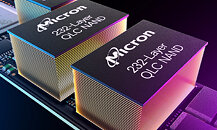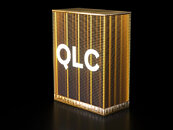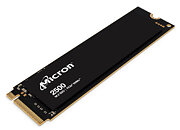TheLostSwede
News Editor
- Joined
- Nov 11, 2004
- Messages
- 18,111 (2.45/day)
- Location
- Sweden
| System Name | Overlord Mk MLI |
|---|---|
| Processor | AMD Ryzen 7 7800X3D |
| Motherboard | Gigabyte X670E Aorus Master |
| Cooling | Noctua NH-D15 SE with offsets |
| Memory | 32GB Team T-Create Expert DDR5 6000 MHz @ CL30-34-34-68 |
| Video Card(s) | Gainward GeForce RTX 4080 Phantom GS |
| Storage | 1TB Solidigm P44 Pro, 2 TB Corsair MP600 Pro, 2TB Kingston KC3000 |
| Display(s) | Acer XV272K LVbmiipruzx 4K@160Hz |
| Case | Fractal Design Torrent Compact |
| Audio Device(s) | Corsair Virtuoso SE |
| Power Supply | be quiet! Pure Power 12 M 850 W |
| Mouse | Logitech G502 Lightspeed |
| Keyboard | Corsair K70 Max |
| Software | Windows 10 Pro |
| Benchmark Scores | https://valid.x86.fr/yfsd9w |
Micron Technology, Inc., today demonstrated its continued NAND technology leadership by announcing that its 232-layer QLC NAND is now in mass production and shipping in select Crucial SSDs, in volume production to enterprise storage customers and sampling to OEM PC manufacturers in the Micron 2500 NMVe SSD.
Micron 232-layer QLC NAND delivers unparalleled performance for use cases across mobile, client, edge and data center storage by leveraging these important capabilities:



"Micron's 232-layer QLC NAND is a key enabler of our high-capacity DirectFlash Module," said Bill Cerreta, general manager of Hyperscale at Pure Storage. "Thanks to Micron's NAND innovation, Pure Storage can take one more step on its quest to replace all HDDs in the data center by 2028."
View at TechPowerUp Main Site | Source
Micron 232-layer QLC NAND delivers unparalleled performance for use cases across mobile, client, edge and data center storage by leveraging these important capabilities:
- Industry-leading bit-density, up to 28% more compact than leading competitors' latest products
- Industry-leading NAND I/O speeds of 2400 MT/s, a 50% improvement over the prior generation
- 24% better read performance over the prior generation
- 31% better programming performance over the prior generation



"Micron's 232-layer QLC NAND is a key enabler of our high-capacity DirectFlash Module," said Bill Cerreta, general manager of Hyperscale at Pure Storage. "Thanks to Micron's NAND innovation, Pure Storage can take one more step on its quest to replace all HDDs in the data center by 2028."
View at TechPowerUp Main Site | Source


